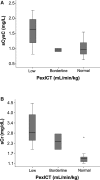Evaluation of Cystatin C for the Detection of Chronic Kidney Disease in Cats
- PMID: 27461722
- PMCID: PMC5108422
- DOI: 10.1111/jvim.14256
Evaluation of Cystatin C for the Detection of Chronic Kidney Disease in Cats
Abstract
Background: Serum cystatin C (sCysC) and urinary cystatin C (uCysC) are potential biomarkers for early detection of chronic kidney disease (CKD) in cats. An in-depth clinical validation is required.
Objectives: To evaluate CysC as a marker for CKD in cats and to compare assay performance of the turbidimetric assay (PETIA) with the previously validated nephelometric assay (PENIA).
Animals: Ninety cats were included: 49 CKD and 41 healthy cats.
Methods: Serum CysC and uCysC concentrations were prospectively evaluated in cats with CKD and healthy cats. Based on plasma exo-iohexol clearance test (PexICT), sCysC was evaluated to distinguish normal, borderline, and low GFR. Sensitivity and specificity to detect PexICT < 1.7 mL/min/kg were calculated. Serum CysC results of PENIA and PETIA were correlated with GFR. Statistical analysis was performed using general linear modeling.
Results: Cats with CKD had significantly higher mean ± SD sCysC (1.4 ± 0.5 mg/L) (P < .001) and uCysC/urinary creatinine (uCr) (291 ± 411 mg/mol) (P < .001) compared to healthy cats (sCysC 1.0 ± 0.3 and uCysC/uCr 0.32 ± 0.97). UCysC was detected in 35/49 CKD cats. R(2) values between GFR and sCysC or sCr were 0.39 and 0.71, respectively (sCysC or sCr = μ + GFR + ε). Sensitivity and specificity were 22 and 100% for sCysC and 83 and 93% for sCr. Serum CysC could not distinguish healthy from CKD cats, nor normal from borderline or low GFR, in contrast with sCr.
Conclusion: Serum CysC is not a reliable marker of reduced GFR in cats and uCysC could not be detected in all CKD cats.
Keywords: Chronic kidney disease; Creatinine; Feline; Glomerular Filtration Rate.
Copyright © 2016 The Authors. Journal of Veterinary Internal Medicine published by Wiley Periodicals, Inc. on behalf of the American College of Veterinary Internal Medicine.
Figures




Similar articles
-
Serum Cystatin C Concentrations in Cats with Hyperthyroidism and Chronic Kidney Disease.J Vet Intern Med. 2016 Jul;30(4):1083-9. doi: 10.1111/jvim.13956. Epub 2016 May 7. J Vet Intern Med. 2016. PMID: 27155206 Free PMC article.
-
Analytical validation of a human particle-enhanced nephelometric assay for cystatin C measurement in feline serum and urine.Vet Clin Pathol. 2014 Jun;43(2):226-34. doi: 10.1111/vcp.12144. Epub 2014 Apr 28. Vet Clin Pathol. 2014. PMID: 24773065
-
Serum and urinary cystatin C in cats with feline immunodeficiency virus infection and cats with hyperthyroidism.J Feline Med Surg. 2016 Aug;18(8):658-65. doi: 10.1177/1098612X15592343. Epub 2015 Jun 22. J Feline Med Surg. 2016. PMID: 26101237 Free PMC article.
-
Diagnostic accuracy of serum cystatin C in chronic kidney disease: a meta-analysis.Clin Nephrol. 2015 Aug;84(2):86-94. doi: 10.5414/cn108525. Clin Nephrol. 2015. PMID: 26200185 Review.
-
Cystatin C: a new renal marker and its potential use in small animal medicine.J Vet Intern Med. 2014 Jul-Aug;28(4):1152-64. doi: 10.1111/jvim.12366. Epub 2014 May 9. J Vet Intern Med. 2014. PMID: 24814357 Free PMC article. Review.
Cited by
-
Serum Cystatin C Concentrations in Cats with Hyperthyroidism and Chronic Kidney Disease.J Vet Intern Med. 2016 Jul;30(4):1083-9. doi: 10.1111/jvim.13956. Epub 2016 May 7. J Vet Intern Med. 2016. PMID: 27155206 Free PMC article.
-
Plasma symmetric dimethylarginine and creatinine concentrations and glomerular filtration rate in cats with normal and decreased renal function.J Vet Intern Med. 2021 Jan;35(1):303-311. doi: 10.1111/jvim.15975. Epub 2020 Dec 4. J Vet Intern Med. 2021. PMID: 33274800 Free PMC article.
-
Renal biomarkers in cats: A review of the current status in chronic kidney disease.J Vet Intern Med. 2022 Mar;36(2):379-396. doi: 10.1111/jvim.16377. Epub 2022 Feb 26. J Vet Intern Med. 2022. PMID: 35218249 Free PMC article. Review.
-
Biomarkers for chronic kidney disease in dogs: a comparison study.J Vet Med Sci. 2020 Aug 28;82(8):1130-1137. doi: 10.1292/jvms.20-0125. Epub 2020 Jul 23. J Vet Med Sci. 2020. PMID: 32581150 Free PMC article.
-
Urinary Exosome-Derived microRNAs Reflecting the Changes in Renal Function in Cats.Front Vet Sci. 2018 Nov 20;5:289. doi: 10.3389/fvets.2018.00289. eCollection 2018. Front Vet Sci. 2018. PMID: 30525049 Free PMC article.
References
-
- Lulich JP, Osborne CA, Obrien TD, et al. Feline renal failure: Questions, answers, questions. Comp Cont Educ Pract 1992;14:127–154.
-
- Lund EM, Armstrong PJ, Kirk CA, et al. Health status and population characteristics of dogs and cats examined at private veterinary practices in the United States. J Am Vet Med Assoc 1999;214:1336–1341. - PubMed
-
- DiBartola SP, Rutgers HC, Zack PM, et al. Clinicopathologic findings associated with chronic renal disease in cats: 74 cases (1973‐1984). J Am Vet Med Assoc 1987;190:1196–1202. - PubMed
Publication types
MeSH terms
Substances
LinkOut - more resources
Full Text Sources
Other Literature Sources
Medical
Research Materials
Miscellaneous

